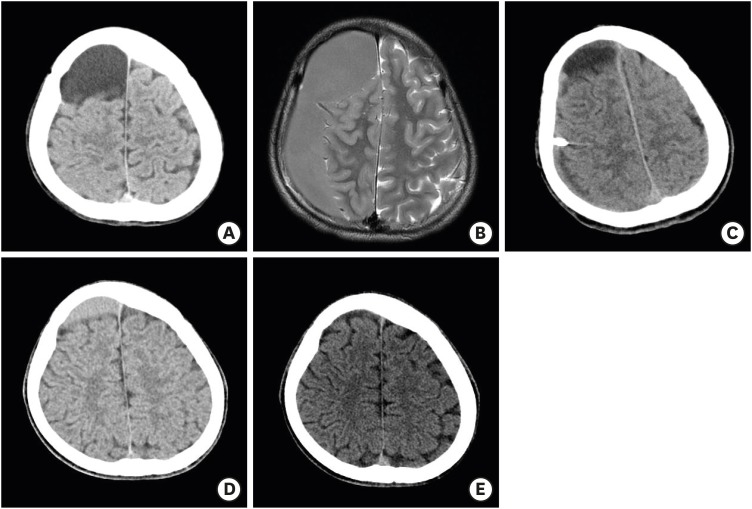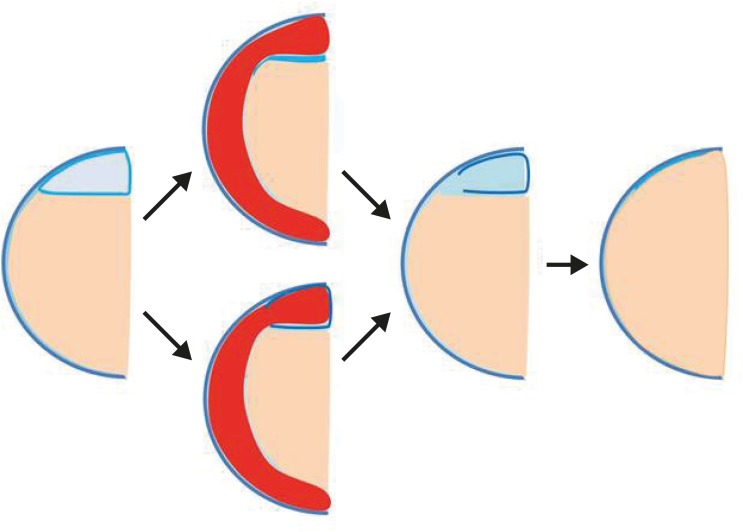Korean J Neurotrauma.
2019 Oct;15(2):159-163. 10.13004/kjnt.2019.15.e15.
Spontaneous Disappearance of an Arachnoid Cyst after Burr Hole Drainage of Chronic Subdural Hematoma
- Affiliations
-
- 1Department of Neurosurgery, Inje University Haeundae Paik Hospital, Busan, Korea.
- 2Department of Neurosurgery, Gyeongsang National University Changwon Hospital, Gyeongsang National University School of Medicine, Changwon, Korea. jheaj@hanmail.net
- KMID: 2461121
- DOI: http://doi.org/10.13004/kjnt.2019.15.e15
Abstract
- It is well known that the presence of arachnoid cysts (ACs) in young patients is a risk factor for developing a chronic subdural hematoma (CSDH) after a minor head injury. Although there have been controversies with the treatment, most authors recommend only draining the CSDH if the AC is asymptomatic. This judgement is based on the facts that this surgical approach has shown good clinical outcomes, and the AC usually remains unchanged after the surgery. Our case demonstrates that the AC of a young patient who developed a CSDH after a minor head injury completely disappeared after a burr hole drainage of the CSDH. Although the chances of an AC disappearing are low, this case shows that an AC might disappear after only draining a CSDH when a rupture of the AC membrane is identified. In such cases, we recommend first draining only the CSDH for the treatment of AC-associated CSDHs.
MeSH Terms
Figure
Reference
-
1. Al-Holou WN, Yew AY, Boomsaad ZE, Garton HJ, Muraszko KM, Maher CO. Prevalence and natural history of arachnoid cysts in children. J Neurosurg Pediatr. 2010; 5:578–585. PMID: 20515330.
Article2. Domenicucci M, Russo N, Giugni E, Pierallini A. Relationship between supratentorial arachnoid cyst and chronic subdural hematoma: neuroradiological evidence and surgical treatment. J Neurosurg. 2009; 110:1250–1255. PMID: 18976058.
Article3. Hall A, White MA, Myles L. Spontaneous subdural haemorrhage from an arachnoid cyst: a case report and literature review. Br J Neurosurg. 2017; 31:607–610. PMID: 27279460.
Article4. Kwak YS, Hwang SK, Park SH, Park JY. Chronic subdural hematoma associated with the middle fossa arachnoid cyst: pathogenesis and review of its management. Childs Nerv Syst. 2013; 29:77–82. PMID: 22914923.
Article5. Mori K, Yamamoto T, Horinaka N, Maeda M. Arachnoid cyst is a risk factor for chronic subdural hematoma in juveniles: twelve cases of chronic subdural hematoma associated with arachnoid cyst. J Neurotrauma. 2002; 19:1017–1027. PMID: 12482115.
Article6. Mori T, Fujimoto M, Sakae K, Sakakibara T, Shin H, Yamaki T, et al. Disappearance of arachnoid cysts after head injury. Neurosurgery. 1995; 36:938–941. PMID: 7791985.
Article7. Nadi M, Nikolic A, Sabban D, Ahmad T. Resolution of middle fossa arachnoid cyst after minor head trauma - stages of resolution on MRI: case report and literature review. Pediatr Neurosurg. 2017; 52:346–350. PMID: 28848171.
Article8. Page A, Paxton RM, Mohan D. A reappraisal of the relationship between arachnoid cysts of the middle fossa and chronic subdural haematoma. J Neurol Neurosurg Psychiatry. 1987; 50:1001–1007. PMID: 3655804.
Article9. Park HR, Lee KS, Bae HG. Chronic subdural hematoma after eccentric exercise using a vibrating belt machine. J Korean Neurosurg Soc. 2013; 54:265–267. PMID: 24278662.
Article10. Parsch CS, Krauss J, Hofmann E, Meixensberger J, Roosen K. Arachnoid cysts associated with subdural hematomas and hygromas: analysis of 16 cases, long-term follow-up, and review of the literature. Neurosurgery. 1997; 40:483–490. PMID: 9055286.
Article11. Pirayesh Islamian A, Polemikos M, Krauss JK. Chronic subdural haematoma secondary to headbanging. Lancet. 2014; 384:102. PMID: 24998813.
Article12. Seizeur R, Forlodou P, Coustans M, Dam-Hieu P. Spontaneous resolution of arachnoid cysts: review and features of an unusual case. Acta Neurochir (Wien). 2007; 149:75–78. PMID: 17180304.
Article13. Takayasu T, Harada K, Nishimura S, Onda J, Nishi T, Takagaki H. Chronic subdural hematoma associated with arachnoid cyst. Two case histories with pathological observations. Neurol Med Chir (Tokyo). 2012; 52:113–117. PMID: 22362297.14. Takizawa H, Sugiura K, Kudo C, Kadoyama S. Spontaneous disappearance of a middle fossa arachnoid cyst--a case report. No To Shinkei. 1991; 43:987–989. PMID: 1799503.15. Takizawa K, Sorimachi T, Honda Y, Ishizaka H, Baba T, Osada T, et al. Chronic subdural hematomas associated with arachnoid cysts: significance in young patients with chronic subdural hematomas. Neurol Med Chir (Tokyo). 2015; 55:727–734. PMID: 26345665.
Article16. Wester K, Helland CA. How often do chronic extra-cerebral haematomas occur in patients with intracranial arachnoid cysts? J Neurol Neurosurg Psychiatry. 2008; 79:72–75. PMID: 17488784.
Article
- Full Text Links
- Actions
-
Cited
- CITED
-
- Close
- Share
- Similar articles
-
- Disappearance of Arachnoid Cyst after Burrhole Trephination: Case Series
- Treatment of Chronic Subdural Hematoma with Arachnoid Cyst
- Arachnoid Cyst with Spontaneous Intracystic Hemorrhage and Chronic Subdural Hematoma
- Cerebellar Hemorrhage after Burr Hole Drainage of Supratentorial Chronic Subdural Hematoma
- Burr Hole Drainage versus Small Craniotomy of Chronic Subdural Hematomas



